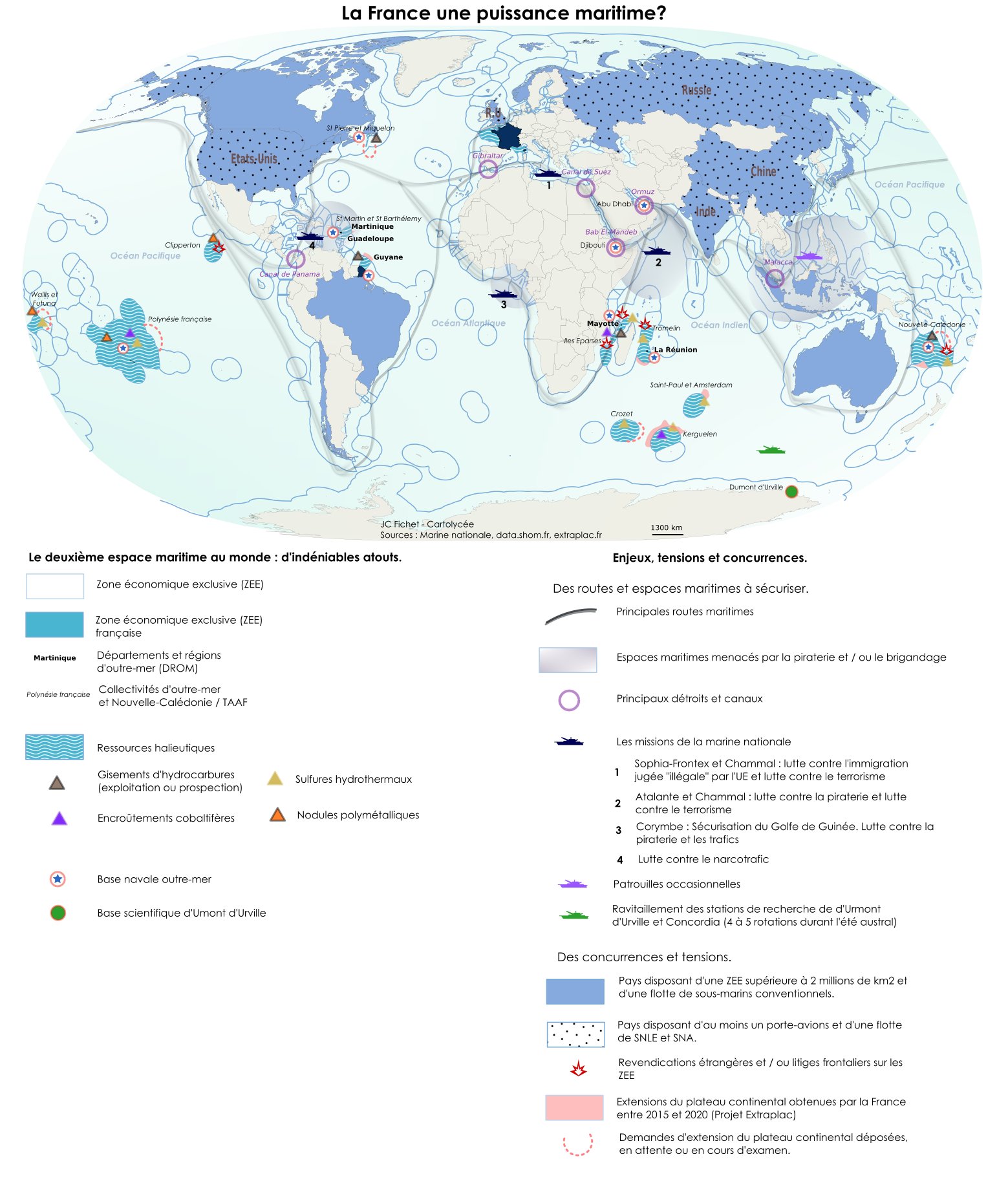Saturday, October 16, 2021
British Isles & misc. (UKHO) update in the GeoGarage platform
Hell or High Seas - Official Trailer
Every day in America over 20 veterans die of suicide.
A portion of the proceeds from ticket sales will go to american odysseus sailing foundation, the tax exempt 501(c)3 co-founded by Taylor Grieger.
Friday, October 15, 2021
When seas and maps impact geostrategy and the future
Sovereign territory is key for power and for activities.
This principle will most probably remain more or less so in the foreseeable future.
Thus, what is the territory over which each state is sovereign?
We think we, of course, know the answers to these questions.
Certainly, for example, the largest states must be Russia, the U.S., Canada and China.
Certainly, European states are strong only in geographical Europe.
But what if these answers were wrong? What if the real international and global world within which we live and will live looked quite differently from the representations to which we are most often used?
It insists on the importance to consider the seas and sovereignty over maritime territories globally rather than to look solely at outdated representations centred on landmass.
It highlights geo-strategic consequences of this “revised” territorial representation of the world and underlines a few recommendations.
Classical representation of the world
Representation of the world, maps and strategy
If we want to design and implement successful strategies, then we need to make sure our mental representations are close enough to reality.
Our conceptions of the geographical space within which we live will constrain and enable what we deem as possible, our vision and objectives, how we design and carry out strategies to realise our objectives, planning and implementation of policies.
They are keys in terms of envisioning global power interplay, which country we think has most chances to win or lose, to be a superpower or not, to be part significantly of the international order or not.
They are keys in terms of defense and security, from classical defence and war to planning ahead for threats stemming from climate change, biodiversity loss and more generally ecosystems’ changes.
The are key in economic terms.
They are key in terms of deciding where to locate factories and offices.
They are key in terms of logistics.
For example, modern geography and especially mapping has been critical in the development of nation-ness and the idea of a nation.
It has been no less critical in allowing for the imposition of the principles of the modern nation-state worldwide – i.e.
sovereignty, territoriality and independence (see with a related bibliography Hélène Lavoix, “The Power of Maps“, The Red Team Analysis Society, 2012).
A classical focus on landmass
250) created around 1250 (Ulrich Harsch Bibliotheca Augustana).
It looks as illustrated in the images below:

Tabula Peutingeriana, 1-4th century CE.
Facsimile edition by Konrad Miller, 1887/1888, Public Domain via Wikimedia Commons – Click on image to access on ZoomViewer.
The political centredness of Rome is also highlighted (second image).
Currently, the 21st century Mappa Mundi to which we are used looks as below:
 Political Map of the World from the Central Intelligence Agency‘s World Factbook 2015, Public Domain.
Political Map of the World from the Central Intelligence Agency‘s World Factbook 2015, Public Domain.The source of the map, the CIA World Factbook, tells us that it is indeed the most common and widespread perception of the world in terms international security, international relations, and geopolitics, as well as economic activity.
With this type of maps, we focus on known land-mass, with small and tiny islands powered over oceans.
We also look at distance between sovereign, independent and territorial states.
We are interested in borders and especially contested boundaries.
In case of disputes on boundaries, then we focus on more precise and detailed maps, such as the one below for the potential for conflict in the East and South China Sea.

 Chinese Territorial Claims and Disputes, the U.S.
Chinese Territorial Claims and Disputes, the U.S.view – 2020 China Military Power Report to Congress – Department of Defense
Similar maps are drawn according to domains and interests, from energy to mining, through military commands and armies.
Whatever the outlook, the framework for the representation is landmass first, accessorily, unfortunately or even unimportantly in the middle of oceans, handled through ports and transportation lanes.
Seeing the Seas and under the Seas
Updating maps
Now, this focus on main continental landmasses gives us a wrong picture of reality.
Two fundamental elements are lacking: exclusive economic zones (EEZ) and continental shelf, which led to claims for extended continental shelf (ECS).
Maybe the easiest way to understand what the EEZ and the continental shelf represent in geopolitical terms is first to imagine the earth without the oceans.
Emerged lands (the current landmasses) would then appear as the top of more or less large mountains and plateaux.
What we perceive usually as a state’s territory would be located starting from the top of these mountains or plateaux to the coast line (or land boundary as agreed with neighbours).
Another slice of territory would be located around the country and spread over 12 nautical miles (the territorial sea).
Then another much larger territory would be located within the next “boundary” line, at 200 nautical miles (the EEZ) from the coastline.
Finally, a last slice of territory would spread, if it exists, over 360 nautical miles of the continental shelf to which the mountain or plateau belongs, starting from the coast line, or if the continental shelf is smaller than 350 nautical miles, then its end.*
 Jean-Benoît Bouron provides a very clear graphic showing these different zones in « Mesurer les Zones Économiques Exclusives », Géoconfluences, mars 2017
Jean-Benoît Bouron provides a very clear graphic showing these different zones in « Mesurer les Zones Économiques Exclusives », Géoconfluences, mars 2017All the ground within the last ECS revisited boundary is under the sovereign jurisdiction of the state, more or less as for usual emerged landmass*, which includes all exploitation rights.
Then you can fill in again the depth with the water of the seas and oceans.
All the water that is within the 200 nautical miles is under the sovereign juridiction of the state.
For the European Union, for example, the right map with the EEZs looks like the image below (access through the European Marine Observation and Data Network (EMODnet) portal).
 EMODnet Map of the EU countries plus the UK and their EEZ – 13 November 2020 – Click on image to access interactive map
EMODnet Map of the EU countries plus the UK and their EEZ – 13 November 2020 – Click on image to access interactive mapYet, even this much better map is not completely correct.
We must add to it the extended continental shelf (ECS) claims each country had to submit by 13 May 2009 (for more details, Helene Lavoix, “The Deep-Sea Resources Brief“, updated 5 January 2018).
If you click on an area, on the interactive mapping website by GRID Arendal, then you will see which country laid claim to this area, as well as the status of the claim.
Now, if we combine all maps, we obtain a representation of the world that is very different indeed from what we are used to (note that Antarctica territories are still missing from these maps**).
Which international actors are truly global powers?
The only truly geographically global power is the European Union, as long as it remains united.
The loss of Great Britain was a serious blow in geopolitical terms, with the loss of South Atlantic supremacy.
Comparatively, the U.S. is a Pacific power.
Furthermore, the EU’s total EEZs represent 20,07 million km2, while the next power, the U.S., only totals 12,17 million km2 (Jean-Benoît Bouron, “Mesurer les Zones Économiques Exclusives“, Géoconfluences, 23 Mars 2017).



China remains within its traditional boundaries, to which the disputed South and East China Sea zones must be added.
The absence of maritime and continental shelf possessions for China contributes strongly to explain its extremely active multinational and international vision as well as its related efforts with the International Seabed Authority (ISA), regarding the Arctic and Antarctica (see Helene Lavoix, “The Ultimate Key Technologies of the Future (3) – Extreme Environments“, The Red Team Analysis Society, June 2021; Jean-Michel Valantin, “Antarctic China (2) – China’s Planetary Game” and “Antarctic China (1): Strategies for a Very Cold Place“, 31 May & 28 June 2021, as well as Jean Michel Valantin articles on the Arctic, The Red Team Analysis Society).
If China wants to be a global power with a corresponding geographical basis, it has no other choice.
China’s space strategy may also be seen within this framework as, by completely displacing the “theatre of operations”, and making it planetary and not only earthly, then China could make partly obsolete its worldwide lack of presence on the globe.
Changing a component of power: a different ranking relative to territory
With the new global map revisited to add the EEZs and ECSs, the real size and potential power of states changes.


Russia is the largest international actor, closely followed the EU.
The U.S. arrives next.
China is far beyond.
India is even further away.
Australia then Canada, however, arrive right after the U.S.
Yet, Canada EEZs is exclusively located around its landmass, nonetheless making it an Arctic power.
Australia has, thanks to the sea and its EEZs, a substantial presence in the Indian Ocean.
In terms of states, despite small initial landmasses, France becomes the 7th largest country in the world – on a par with China – while New Zealand and the UK respectively become the 9th and 10th largest countries.
Germany ranks far below and was added only for the sake of comparison.
France, indeed, has the second largest maritime territory after the U.S. and this territory is spread principally in the Pacific and Indian Oceans.
The U.S. is absent from the Indian Ocean.
Even though it is not visible on the maps, the U.S. is an Arctic power but not an Antarctic one, while France is an Antarctic power but not and Arctic one.
The UK with also a global presence is especially strong in the South Atlantic Ocean.

Left: NOAA’s Exclusive Economic Zone (EEZ) of the United States and affiliated islands (dark blue).
Taking stock of the maritime dimension of territory and power
Hence, it would be logical, strategically, that France, the UK and the EU conceptualise their power in terms of territory and notably maritime territory.
This may come easily to the UK considering its history, but may be much harder for the EU and France.
On the contrary, China, and in a lesser way Russia, are fundamentally land-based powers, which, of course, is far from stopping them to develop maritime power (Valantin, Arctic articles, Ibid.).
Yet, in the case of China, it has to do so without “points d’appuis”, hence the critical importance of the maritime part of the Chinese Belt and Road, that supplements China’s lack of substantial maritime territory (Valantin, “Militarizing the Maritime New Silk Road“, The Red Team Analysis Society, 3 April 2017).
The importance of this maritime territory seems to start being considered at the EU level, as, for example, the “EU extend[ed] trade defence rules to continental shelf and exclusive economic zones of Member States” on 3rd July 2019.
Yet trade is only a part of the instruments of power.
Further detailed research and assessment would be needed here.
A difficult adaptation: the complex case of France?
If we look, as another example, at the official 2019 French Army document, France and Security in the Indo-Pacific, it appears quite clearly that old representations are hard-lived.
It seems to be difficult to fully start thinking in terms of global territoriality, as shown in the first map of the gallery below.
This does not mean that all French actors have an outdated vision, as shown for example, by the Ifremer, the report of the French Economic Social and Environmental Council (CESE) mentioned below, or the more recent portail national des limites maritimes, using only the maps they provide as weak signals (second, third and fourth map in the gallery below).




Yet, be it for lack of understanding, vision or something else, for unknown reasons, in 2009, France withdrew the filing of the preliminary information regarding the ECS of Clipperton, thus abandoning or postponing the assertion of sovereign rights.
This was done under President Sarkozy, of the Republican Party (right, LR).
This abandon was denounced, for example, by the special report of the French Economic Social and Environmental Council (CESE), which is only consultative (Gérard Grignon, “Extension of the Continental shelf beyond 200 nautical miles:an asset for France“, 2013, pp.
25 & 33, 125-129), as: “an unacceptable abandoning of the sovereignty of France over its legitimate pretentions.”Grignon, “Extension of the Continental shelf beyond 200 nautical miles:an asset for France“, p.33
Obviously, nothing has been done to remedy this incredible action and submit the claim as recommended, as the official website of the national maritime limits does not list any ECS for Clipperton (portail national des limites maritimes, “tableau des superficies”, access 15 sept 2021), despite French rights, the existence of resources such as hydrothermal sulfur (Grignon, ibid.
p.141 using Ifremer, note N°3 Ocean Mineral Resources, September 21, 2012), and possibly polymetallic nodules.
In general, considering the overall French territory, it looks like the French ECS are particularly small.
Indeed, for example, apart from Clipperton, other territories were not followed up and no preliminary information was filed for them during the Sarkozy and then Holland Presidency (Grignon, Ibid., p.61, 125-133).
As a whole, it would seem that 725.297 km2 of ECS have been recognised (“tableau des superficies”), when the CESE calculates that 2.510.544 km2 could be claimed (Grignon, pp.134-135).
2.5 million km2 correspond to 3,7 times the French emerged territory.
The diversity of visions – and actions – of the various French actors should not be a surprise and has long presided over the destiny of the country, notably when exploration and overseas territory are concerned (from Jacques Cartier and the Nouvelle France, to the “Loss of India” – actually trade posts – under Louis XV, through settlements in the French American territories, support of the Americans in the War of Independence, the necessity to go against Napoleon III for a global vision, or the refusal to rely on and completely consider Protectorates and Colonies during World War II, despite demands by the people of these territories – e.g. among others, Raoul Girardet, L’Idée Coloniale en France, (Paris, Hachette/Pluriel, [1972], 1978); Catherine Coquery-Vidrovitch, « La colonisation française 1931-1939;» in Histoire de La France Coloniale : III.
Le Déclin, ed. Vol.3 (Paris: Armand Colin, Agora, 1991); Helene Lavoix, ‘Nationalism’ and ‘genocide’ : the construction of nation-ness, authority, and opposition – the case of Cambodia (1861-1979) – PhD Thesis – School of Oriental and African Studies, University of London, 2005).
Yet, France is de facto the first power in the Indian Ocean.
It is also a very strong power in the Pacific possibly on a par with the United States (for the Southern part).
Interestingly, if we think about the old 19th century idea of François Guizot, the policy of “points d’appuis” across the globe allowing for force’s projection (and initially coal and other supplies for steamboats in the then competition with the UK, see Lavoix, Nationalism and Genocide, Ibid.), then the French Caribbean Islands and Clipperton are important locations to reach French areas in the Pacific.
Improbable neighbours
Another consequence of looking globally at the territory of international actors is to become fully aware of the existence of “improbable” neighbours.
For example, Australia and France are neighbours, around the Kerguelen islands and New Caledonia.
Australia and Norway similarly are neighbours (North of Antarctica).
These relationships exist also considering neighbourhood on Antarctica**.
This entails possibly thinking differently about alliances or to the least strong cooperation.
Why does that matter and recommendations
Among the crucial factors that will shape our future, we find climate change and biodiversity loss, or more largely ecosystems’ changes, and ressources (including energy) rarefaction, all leading us to increasingly use new, more extreme, territories.
One such extreme territory is the deep-sea, which involves knowing it, protecting it yet using it.
As a result, being able to exploit in a truly sustainable way the abyss, to then transport the obtained ressources where they are needed, to police the related areas and secure them will be of primary importance.
Being sovereign over such territories, which are de facto maritime, will be a factor of wealth and survival.
Being able to use these territories strategically is no less important, as shown by the Chinese efforts and successes in this field (e.g. Lavoix, “The Ultimate Key Technologies…”, Ibid.).
The links between the global maritime domain and space should be neither forgotten nor underestimated as space is key for navigation and communications for example.
Halieutic resources and their preservation, of course, should not be forgotten.
Groups of interested players, be they public, private or mix, should move forward to invest and develop sustainable capabilities and management of flows in the EEZs and ECS, more particularly in the deep-sea.
They should include start-ups and make sure innovation and multi-disciplinary research is fully included.
They may have to apply lobbying pressure on states.
This strategy could be particularly useful when or if official rulers and administrations happily practice neglect to the point of default.
Companies should rethink their strategies to consider how the world truly looks like and how related alliances and tensions may evolve and impact their activity.
States, diplomats and armies should make sure they have and will have the means to ensure the security of the territory under their sovereignty, especially considering the increasingly tense context and the rising challenges of the future.
Note
* We are here adopting a geopolitical approach, not an international law dispute vision.
Our purpose is not discuss the differences between sovereignty and boundaries related to territorial sea, EEZs, preeminence of the law of the sea, etc, nor the relationships between power, force, international relations, international law, international system, etc.
**”As the Washington Treaty of 1 December 1959 froze all claims to the Antarctic continent, possessor states, such as France, cannot exercise sovereignty or jurisdiction over the waters beyond the Antarctic territory they claim.
Requests to extend the continental shelf are also suspended.
As a result, the maritime spaces relating to Adelie Land are not included in the maritime spaces currently in force for France.” (Limites maritimes, Tableau des superficies, 2021).
- When Seas and Maps Impact Geostrategy and the Future
- Signals: China Planetary 3D Strategy, Deep Sea Resources in the South China Sea
- The Deep-Sea Resources Brief
- Militarizing the Chinese New Silk Road (part 1)
- The Deep-Sea Resources Sigils
- When Seas and Maps Impact Geostrategy and the Future
- Signals: China Planetary 3D Strategy, Deep Sea Resources in the South China Sea
- The Deep-Sea Resources Brief
- Militarizing the Chinese New Silk Road (part 1)
- The Deep-Sea Resources Sigils
- GeoGarage blog : France’s new marine protection strategy should include stronger safeguards, experts say
Thursday, October 14, 2021
The global transition to remote and autonomous operations
The Benefits and Challenges Facing the Maritime Industry
Over the next five years, we will witness a significant reduction in the maritime industry’s reliance on larger vessels, as the focus on compact and agile uncrewed surface vessels (USVs) increases and a wider transition towards remote marine operations continues to gather momentum.
The benefits as well as the legal framework challenges of remote and autonomous operations will have a profound impact on the energy and maritime industries.
The ability to plan, manage and monitor offshore projects, and to maintain assets and infrastructure, through remote operations and autonomous capabilities is increasingly critical within the energy and maritime industries.
Through their flexible deployment and good connectivity with onshore remote operations centres (ROCs), USVs can acquire data to support these objectives faster than ever before.
USVs also provide significant benefits when it comes to safety: used as force multipliers alongside crewed parent vessels, they allow crewed vessels to remain at a safe distance from assets such as wind turbines and avoid unnecessary risk for those onboard.
This has the potential to translate into a 100% reduction in human exposure to hazardous offshore environments where, rather than transmitting their situational awareness and vessel status data to personnel onboard parent vessels, USVs will ultimately be solely controlled from the safety of an onshore location, such as one of Fugro’s ROCs.
Additionally, clients are increasingly looking to reduce the environmental impact of their operations in line with the zero emission targets presented in the UK government’s Maritime 2050 route map.
The global transition towards remote and autonomous working will help to reduce the greenhouse gases emitted by the maritime industry, as hybrid USVs consume up to 95% less fuel than conventional vessels.
However, despite these obvious advantages, as innovation outpaces regulation, the legal framework in which USVs operate remains a challenge.
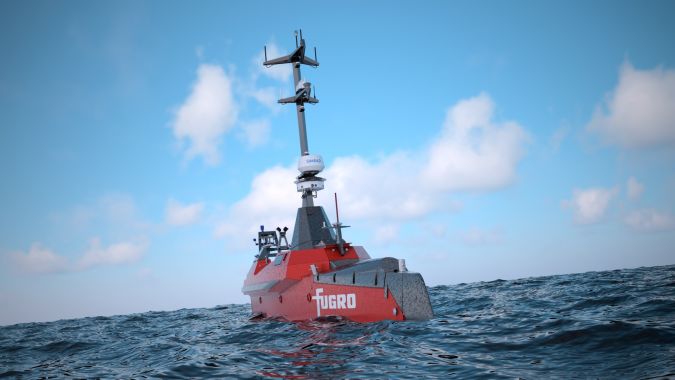 Fugro’s Blue Shadow next-generation uncrewed surface vehicle.
Fugro’s Blue Shadow next-generation uncrewed surface vehicle.Maritime Legislation for Uncrewed Vessels
As is the case with the rapid development of any new technology, it is challenging to create fixed ruling that leaves room for constant innovation and the continued progression of new methods of working.
One of the first attempts at this will be the revised workboat code being developed by the Maritime and Coastguard Agency (MCA), expected by the start of 2022.
The focus of this forthcoming legislation is expected to shift from the safety of crew onboard to the safety of other seagoing vessels and the wider environment.
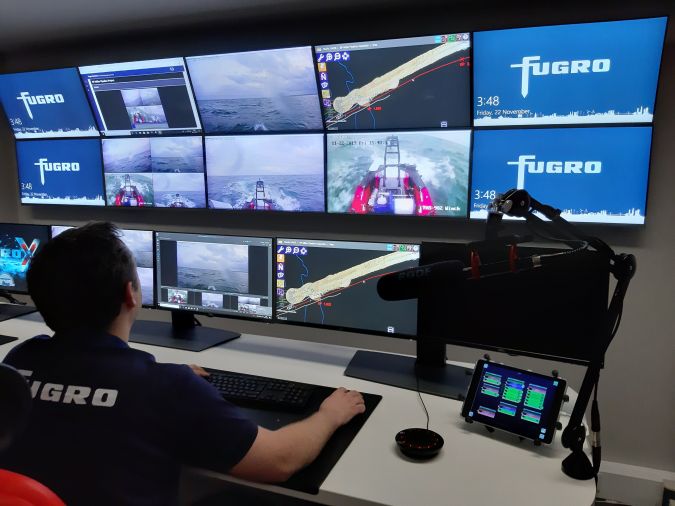 Fugro’s Blue Shadow hydrographic survey operations displayed onscreen in a Fugro remote operations centre.
Fugro’s Blue Shadow hydrographic survey operations displayed onscreen in a Fugro remote operations centre.Much like self-driving cars, societal acceptance is crucial to the adoption of these new technologies, where they are expected to work correctly 100% of the time with no margin for error.
While collision avoidance systems are being developed to improve USVs’ navigation safety, the question of public trust remains: can we trust a USV to be left alone at sea and respond as a conventional crewed vessel would? If not, how do we ensure that the people who are remotely monitoring and controlling them have the same situational awareness as they would onboard?
The regulations which eventually come into force will need to balance the developmental freedom to truly revolutionize the way in which the maritime industry operates with the ongoing protection of those human lives still at sea, while also improving safety standards and protecting the environment.
Fugro’s Blue Shadow is a globally deployed, next-generation 9m autonomous and uncrewed hydrographic survey platform delivering nearshore seabed insights faster.
Part of Fugro’s overall hydrographic solution, Blue Shadow is one of many from its fleet of USVs ranging from 9m to 24m, within the suite of remote and autonomous capabilities that are more sustainable when compared to conventional vessels.
Sustainability of USVs is an advantage built into their design concept from the beginning: vessels whose function is purely to survey and acquire data can of course be much smaller than traditional vessels, which are designed to transport people and cargo.
Fugro recently completed its first remotely operated hydrographic survey using Blue Shadow to capture hydrographic and bathymetric data to support safe navigation, nautical charting, marine site characterization and resource management activities.
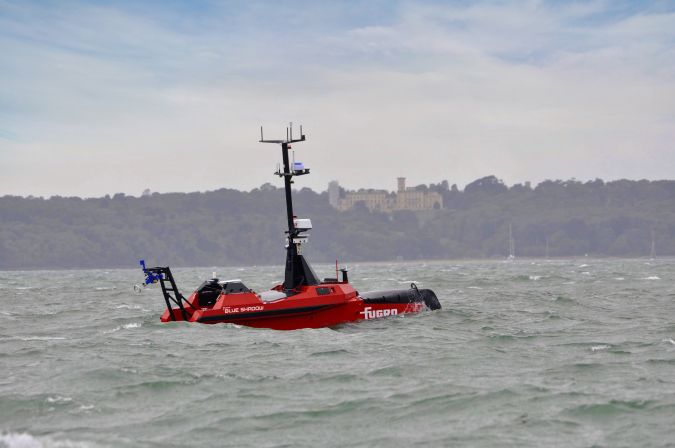 Fugro’s Blue Shadow performing its autonomous survey trials off the coast of Portchester, UK.
Fugro’s Blue Shadow performing its autonomous survey trials off the coast of Portchester, UK.Executed during challenging environmental conditions, including waves of up to 2m, the compact, wave-piercing design of the USV allowed it to acquire high-quality data in conditions that would have been unworkable for conventional vessels.
This lengthening of the potential work window increases surety of project delivery, providing more opportunities throughout the year to acquire much-needed data for clients.
The survey operations also achieved, depending on the sea conditions, a 61% to 96% reduction in greenhouse gas emissions through significantly reduced fuel consumption.
Moreover, the innovative collision avoidance and advanced spatial awareness technology built into the Blue Shadow ensured its autonomous operations met the highest safety standards.
While the development and deployment of new remote and autonomous solutions progress, the legal framework will continue to play an essential role in influencing the design and engineering parameters for next-generation USVs and other MASS.
We are currently in a critical phase of the global transition to remote and autonomous maritime operations and it is essential that the legal framework is swiftly put in place to allow these technologies to flourish.
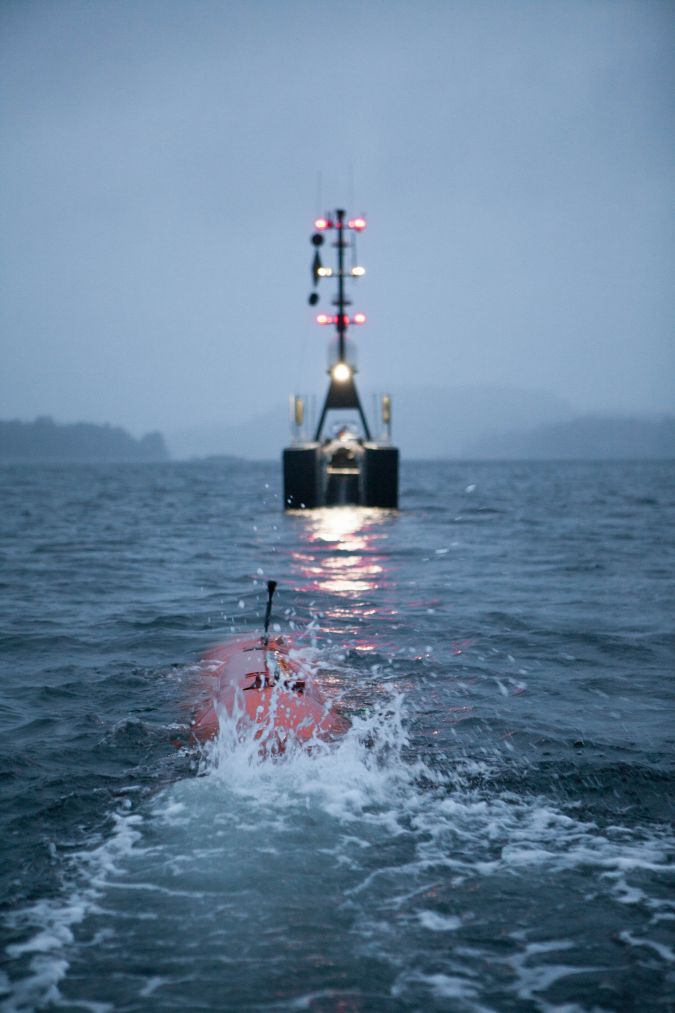
Wednesday, October 13, 2021
The harsh history behind the internet's favorite sea shanty
It's easy to see why "Soon May the Wellerman Come" became TikTok's first viral hit of 2021.
But at the risk of raining on the internet's fun, the cheeriness of the tune is deceptive.
No wonder they wanted to take their leave and go.
The right whale, or the whale right now
 ''South Sea Whale Fishery,' painted in 1836 — when the Wellerman company was most active.
''South Sea Whale Fishery,' painted in 1836 — when the Wellerman company was most active.Colquhoun first published the song in 1965; by sheer coincidence, this was the same year New Zealand banned whaling.
Whale oil was a foul-smelling thing, but its usefulness in lamps, candles, soap, food and industrial lubricants outweighed the odor.

The prices varied wildly from place to place, but in the U.S.
that much whale oil could net you at least $150,000 in today's money, not counting the whale bone.
That might help explain why the Billy o' Tea, the ship in the verses of "Wellerman," spent two weeks looking for a right whale and more than 40 days trying to kill the thing.
The Billy o' Tea — a "Billy" is a pot used for heating water — appears to be a fictional ship.
When the Wellerman came

Edward Weller left Otago in 1840, never to return.
But context is key.
So the next time you hit play on a version of "Wellerman," take a moment to remember the gruesome whale oil business it describes.
Perhaps one day shanties will be sung about modern-day oil companies that are even more damaging to the environment; a rapidly warming planet would certainly be better off if they would take their leave and go.
Links :
- The Guardian : Not just for drunken sailors: how sea shanties took over TikTok / How a Scottish postie's simple sea shanty struck a global chord
- WSJ : ‘Sea Shanty’: Now It’s Yo, Ho, Ho and a TikTok Duet
- NYTimes : Everyone’s Singing Sea Shanties (or Are They Whaling Songs?)
- Time Mag : In These Tumultuous Times, Sea Shanty TikToks Have Suddenly Become a Port in the Storm
- The Conversation : When old sea shanties go viral we know that tradition matters
- JStor Daily : What’s the Difference between a Shanty and a Sea Song?
Tuesday, October 12, 2021
France’s new marine protection strategy should include stronger safeguards, experts say
From Pew by Jérôme Petit
Leading up to France’s announcement, the Pew Bertarelli Ocean Legacy Project partnered with the International Union for Conservation of Nature (IUCN) French Committee to bring experts and stakeholders together in a series of online conferences exploring the need for, and benefits and importance of, high marine protection—which should be the government’s focus now, given that it has almost achieved the 30% goal.
The first conference of this series, held in September 2020, featured 12 French experts focused on ocean health and effective approaches to conserving biodiversity, including establishing fully safeguarded, well-managed marine protected areas (MPAs).
The experts explained that MPAs, specifically those with a high level of protection, provide measurable benefits to marine ecosystems and surrounding communities.
In addition, conference participants highlighted how MPAs can benefit local economies. Research proves that fish are larger and more numerous inside an MPA than outside.
The potential benefits of MPAs can be fully realized only if those areas are large and highly protected, according to experts.
Panelists at another conference, held online in November 2020, noted that these highly protected waters are predominantly located in overseas territories with little traffic and less exposure to human pressures and therefore indicate a “lack of representativeness” of France’s marine habitats worldwide.
As part of its strategy announcement, France pledged to develop three three-year action plans with input from its overseas territories.
A global call for action
The best available science tells us that we need to protect at least 30% of the ocean to conserve biodiversity and ecosystems, improve long-term food security, and protect ocean-based livelihoods.
Monday, October 11, 2021
AI breakthroughs could improve weather forecasts : finding patterns in the data
:max_bytes(150000):strip_icc():format(webp)/GettyImages-1269900764-395951ff92b24ac2a417cb60c75921fa.jpg)
From LifeWire by Sascha Brodsky
Key Takeaways
- Artificial intelligence is combing through vast amounts of data to create more accurate weather forecasts.
- The UK’s weather service has developed an AI tool that can accurately predict the likelihood of rain in the next 90 minutes.
- Spire Global is one company that’s already using AI to enhance forecasts.
Britain's national weather service has developed an AI tool that it claims can accurately predict the likelihood of rain in the next 90 minutes.
"Any industry that is weather-sensitive is looking into ways to use AI to improve safety and operations," Renny Vandewege, the vice president of weather operations at data analytics company DTN, told Lifewire in an email interview.
Today's weather forecasts all come from the most powerful computers on Earth, and they can't even tell you accurately if it's going to rain or not tomorrow.
London is known for gloomy skies, but at least you may have a better warning when sprinkles start. Working with the UK's national weather service, AI company DeepMind has developed a deep-learning tool called DGMR for forecasting.
Experts judged DGMR's forecasts to be the best across a range of factors—including its predictions of the location, extent, movement, and intensity of the rain—89% of the time, according to a paper recently published in the journal Nature.
"We use an approach known as generative modeling to make detailed and plausible predictions of future radar based on past radar," DeepMind wrote on its website.
Appu Shaji, an AI scientist not involved in the DeepMind study, called the company's work "impressive" in an email interview with Lifewire.
"That being said, these works are still in their infancy, and we should expect to see considerable advancement in accuracy and forecasting possibilities in the coming years," he added.
Predicting Chaos
Weather is a chaotic process that's difficult to predict with precision.
"Advanced weather models and technology, like AI, improve forecasting to help us to better plan, prepare and lessen the impact of weather events," Vandewege said.
"As weather events become more frequent and extreme, accurate forecasts with a longer lead time mean businesses, communities and the public have more time and more information to make better decisions."
Weather simulations are currently run using computer models, Vikram Saletore, an AI expert at Intel, told Lifewire in an email interview.
"AI dramatically improves weather forecasting by enabling and accelerating significantly these simulation environments to take in massive amounts of historical models with the current environment as input and run predictions on potential outcomes," Saletore added.
Spire Global is one company that's already using AI programs to enhance forecasts.
"Climate change is increasing the likelihood of extreme weather and global operations open businesses to the threat of weather disruptions anywhere in the world," Matthew Lennie, an AI expert Spire Global, told Lifewire in an email interview.
Computing power has been a bottleneck for weather forecasting.
:max_bytes(150000):strip_icc():format(webp)/GettyImages-89938436-8acd47d81c7c42f8831b59d8be16d59b.jpg)
"AI has an amazing chance to reduce this dependency on powerful engines and potentially run these models to get as good as or better results with significantly less computational load," Shaji said.
The AI method is similar to how stock market investors watch patterns over long periods, Shaji pointed out. "Deep learning has more accuracy," he added.
- GeoGarage blog : Google AI model outperforms traditional methods of weather .. / Better weather forecasts coming to the developing ... / Tracking hurricanes with artificial intelligence / As extreme weather intensifies, a growing need for ... / Can Artificial Intelligence help build better, smarter climate ... / Using deep learning to forecast ocean waves
- UW news : A.I. model shows promise to generate faster, more accurate weather forecasts
- BBC : AI can predict if it will rain in 2 hours'times
- Research : Artificial Intelligence May Be Key to Better Weather Forecasts
- AzoRobotics : The Future Use of Artificial Intelligence in Weather Prediction
- EOS : Artificial Intelligence May Be Key to Better Weather Forecasts
- HPE : Why AI is an increasingly important tool in weather prediction
Sunday, October 10, 2021
How deep ocean really go
In a new video, animator and YouTuber MetaBallStudios helps to tease apart the dark waters of the world. And if you think you know how deep the ocean really is, you may need to think again.
MetaBallStudios (or MBS), a Spanish animator whose real is name is Alvaro Gracia Montoya, recently posted the above video to his channel.
For those unfamiliar, MBS has cranked out countless animated comparison videos before.
The animator has, for example, compared the sizes of various spaceships from Star Wars.
As well as how big various comets in our solar system are.
In this comparison, MBS goes for depth instead of his usual size angle.
The video begins with the Sea of Azov, which is in Eastern Europe and has an average depth of only 23 feet.
From there, MBS slowly works down into deeper and deeper bodies of water, providing familiar structures and event sites as references.
At about 90 seconds in, for example, MBS shows that the average depth of the Timor Sea is 270 feet deeper than the Eiffel Tower is tall.
(That would be over 1,060 feet.)
 MetaBallStudios
MetaBallStudiosThe Atlantic Ocean crushes that depth, however, deepening in(?) at a whopping 27,000 feet deep.

The deepest floor of any ocean on Earth, however, is the Mariana Trench, which is in the western Pacific Ocean.
The trench, which is home to alien crustaceans and sounds that will send chills down your spine, is an astounding 36,000 feet deep.
What’s just as astounding, however, is that explorers have visited there and sadly found plastic waste.
Links :
- GeoGarage blog : Image of the week : the Deep Sea - GeoGarage blog






 Map – One Stop Datashop (OSDS) – Continental Shelf Programme – 13 Sept.
Map – One Stop Datashop (OSDS) – Continental Shelf Programme – 13 Sept.

